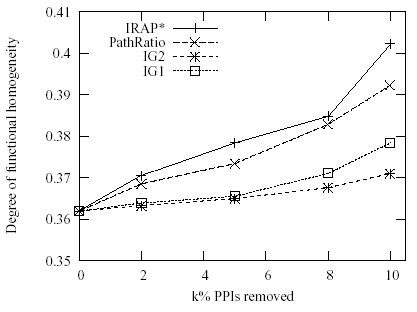
|
|
|---|
|
A new path-based measure, PathRatio, has been proposed by Pei and Zhang recently as an alternative to our IRAP measure. PathRatio was shown to perform better than our IRAP in the top spectrum of the indexed interactome, suggesting that PathRatio was better in detecting true positives. Note that the PathRatio results reported in \cite{Peigjun05} was obtained using a different set of initial weights from the IG1 values used in IRAP; as such, it is unclear whether the difference in performance was solely due to the relative performance of the best-path approach adopted by IRAP versus the all-path approach adopted by PathRatio. However, in our computational repurification application, the performance of detecting false positives is more important than detecting true positives since we are removing a small portion of interactions that have to be confidently deemed as false positives in each iteration. In this aspect, IRAP actually performed comparably if not slightly better than PathRatio. In addition, unlike our IRAP which adopts an efficient best-path approach, PathRatio uses an all-paths approach which is therefore computationally much more intensive. The figure below shows the superiority of IRAP as a false positive filtering measure: as the IRAP threshold is increased, the enriched GO term similarity increases from 0.362 to 0.402, indicating an increased rate of true positives in the filtered interaction data. For comparison, we also show the performance of IG1, IG2 and PathRatio in the figure. With PathRatio, the enriched GO term similarity increases from 0.362 to 0.392, with IG2, the score only increases to 0.378; and with IG1, the proportion only increases to 0.371.
|

All rights reserved.









